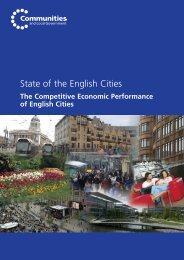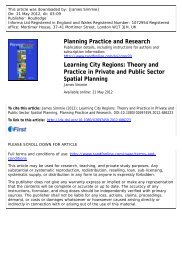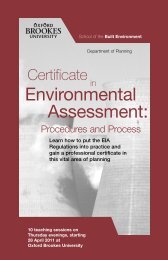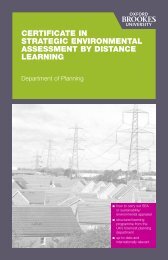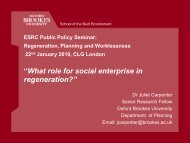History Matters: Path dependence and innovation in British city ...
History Matters: Path dependence and innovation in British city ...
History Matters: Path dependence and innovation in British city ...
You also want an ePaper? Increase the reach of your titles
YUMPU automatically turns print PDFs into web optimized ePapers that Google loves.
Part 1: Introduction<br />
1.1 <strong>History</strong> matters<br />
A number of authors have shown that<br />
capitalist economies evolve through long<br />
cycles of recession, recovery, growth <strong>and</strong><br />
decl<strong>in</strong>e (Kondratieff 1935; Schumpeter 1939;<br />
Mensch 1979), <strong>and</strong> that these cycles develop<br />
differently <strong>in</strong> different places (Marshall<br />
1987; Hall <strong>and</strong> Preston 1988). Such <strong>in</strong>sights<br />
led attention <strong>in</strong>itially to focus on whole<br />
regions such as Silicon Valley <strong>in</strong> California,<br />
Baden-Württemberg <strong>in</strong> Germany <strong>and</strong> Emilia-<br />
Romagna <strong>in</strong> Italy. It later became apparent<br />
that functional <strong>city</strong>-regions were the ma<strong>in</strong><br />
geographic concentrations of economic<br />
activities. This placed them <strong>in</strong> the front l<strong>in</strong>e<br />
of globalisation where they had to rema<strong>in</strong><br />
competitive to survive <strong>and</strong> thrive.<br />
As they became <strong>in</strong>creas<strong>in</strong>gly exposed to<br />
<strong>in</strong>ternational competition, some cities adapted<br />
much better than others. Thus while some<br />
persisted with their traditional <strong>in</strong>dustries until<br />
they were overtaken by foreign competition<br />
or technological change, others seemed better<br />
able to re-<strong>in</strong>vent their old <strong>in</strong>dustrial activities<br />
or create new ones. We are ma<strong>in</strong>ly concerned<br />
with the reasons underly<strong>in</strong>g such long-term<br />
divergence <strong>in</strong> the fortunes of <strong>British</strong> cities.<br />
We argue that an evolutionary economics<br />
approach is key to underst<strong>and</strong><strong>in</strong>g such<br />
long-term economic change. There are four<br />
str<strong>and</strong>s with<strong>in</strong> a local <strong>in</strong>teractive system<br />
which, for the purposes of clarity, we exam<strong>in</strong>e<br />
sequentially. The first str<strong>and</strong> <strong>in</strong>cludes the<br />
sectoral development pathways – the key<br />
<strong>in</strong>dustries – that developed <strong>in</strong> different cities<br />
over decades <strong>and</strong> centuries. They represent<br />
the economic, social <strong>and</strong> <strong>in</strong>stitutional histories<br />
of <strong>city</strong> economies that have brought them<br />
to where they are today. They determ<strong>in</strong>e<br />
what is immediately possible <strong>in</strong> a given <strong>city</strong>’s<br />
economy. This is partly because they determ<strong>in</strong>e<br />
much of the second str<strong>and</strong> of analysis which<br />
<strong>in</strong>cludes the knowledge assets or absorptive<br />
capa<strong>city</strong> of the local economy. These assets –<br />
<strong>in</strong>clud<strong>in</strong>g higher education <strong>and</strong> R&D – have<br />
become <strong>in</strong>creas<strong>in</strong>gly significant as the role<br />
of knowledge <strong>in</strong> contemporary economic<br />
performance has <strong>in</strong>creased. The third str<strong>and</strong><br />
of analysis is concerned with the dynamic use<br />
of knowledge to create new products <strong>and</strong><br />
services. Here the local <strong><strong>in</strong>novation</strong> system plays<br />
a critical role <strong>in</strong> comb<strong>in</strong><strong>in</strong>g local <strong>and</strong> external<br />
knowledge to <strong>in</strong>ject vary<strong>in</strong>g degrees of novelty<br />
<strong>in</strong>to local economic activities. This system plays<br />
a key role <strong>in</strong> select<strong>in</strong>g from the historically<br />
determ<strong>in</strong>ed range of possible pathways those<br />
that develop <strong>in</strong> the future. The more radical<br />
<strong><strong>in</strong>novation</strong>s aris<strong>in</strong>g from this system sometimes<br />
generate new development pathways, where<br />
new types of <strong>in</strong>dustry or economic sector are<br />
<strong>in</strong>volved. This new path creation is the fourth<br />
str<strong>and</strong> of our analysis.<br />
The <strong>in</strong>teractions between such pathways, their<br />
knowledge assets <strong>and</strong> their local <strong><strong>in</strong>novation</strong><br />
system determ<strong>in</strong>e the long-term success<br />
or failure of their economic sectors. They<br />
therefore decide the nature of the sectoral<br />
<strong>and</strong> structural pathways followed <strong>in</strong> particular<br />
<strong>city</strong>-regional economies. In our study, cities<br />
like Leeds, Middlesbrough, Newport, Norwich,<br />
Swansea <strong>and</strong> Wakefield have experienced<br />
decl<strong>in</strong>e <strong>in</strong> many of their <strong>in</strong>dustries <strong>in</strong>herited<br />
from the Industrial Revolution. By contrast<br />
Aldershot, Cambridge, Oxford, Northampton,<br />
Read<strong>in</strong>g <strong>and</strong> Warr<strong>in</strong>gton, relatively<br />
unencumbered by their <strong>in</strong>dustrial heritages by<br />
the early 1980s, have prospered.<br />
We adopt an evolutionary economics approach<br />
to underst<strong>and</strong> such long-term developments<br />
10





